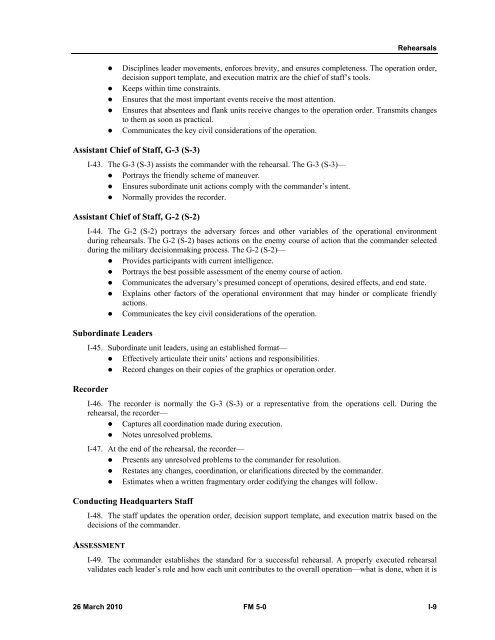FM 5-0, The Operations Process - Federation of American Scientists
FM 5-0, The Operations Process - Federation of American Scientists
FM 5-0, The Operations Process - Federation of American Scientists
You also want an ePaper? Increase the reach of your titles
YUMPU automatically turns print PDFs into web optimized ePapers that Google loves.
Rehearsals<br />
• Disciplines leader movements, enforces brevity, and ensures completeness. <strong>The</strong> operation order,<br />
decision support template, and execution matrix are the chief <strong>of</strong> staff’s tools.<br />
• Keeps within time constraints.<br />
• Ensures that the most important events receive the most attention.<br />
• Ensures that absentees and flank units receive changes to the operation order. Transmits changes<br />
to them as soon as practical.<br />
• Communicates the key civil considerations <strong>of</strong> the operation.<br />
Assistant Chief <strong>of</strong> Staff, G-3 (S-3)<br />
I-43. <strong>The</strong> G-3 (S-3) assists the commander with the rehearsal. <strong>The</strong> G-3 (S-3)—<br />
• Portrays the friendly scheme <strong>of</strong> maneuver.<br />
• Ensures subordinate unit actions comply with the commander’s intent.<br />
• Normally provides the recorder.<br />
Assistant Chief <strong>of</strong> Staff, G-2 (S-2)<br />
I-44. <strong>The</strong> G-2 (S-2) portrays the adversary forces and other variables <strong>of</strong> the operational environment<br />
during rehearsals. <strong>The</strong> G-2 (S-2) bases actions on the enemy course <strong>of</strong> action that the commander selected<br />
during the military decisionmaking process. <strong>The</strong> G-2 (S-2)—<br />
• Provides participants with current intelligence.<br />
• Portrays the best possible assessment <strong>of</strong> the enemy course <strong>of</strong> action.<br />
• Communicates the adversary’s presumed concept <strong>of</strong> operations, desired effects, and end state.<br />
• Explains other factors <strong>of</strong> the operational environment that may hinder or complicate friendly<br />
actions.<br />
• Communicates the key civil considerations <strong>of</strong> the operation.<br />
Subordinate Leaders<br />
I-45. Subordinate unit leaders, using an established format—<br />
• Effectively articulate their units’ actions and responsibilities.<br />
• Record changes on their copies <strong>of</strong> the graphics or operation order.<br />
Recorder<br />
I-46. <strong>The</strong> recorder is normally the G-3 (S-3) or a representative from the operations cell. During the<br />
rehearsal, the recorder—<br />
• Captures all coordination made during execution.<br />
• Notes unresolved problems.<br />
I-47. At the end <strong>of</strong> the rehearsal, the recorder—<br />
• Presents any unresolved problems to the commander for resolution.<br />
• Restates any changes, coordination, or clarifications directed by the commander.<br />
• Estimates when a written fragmentary order codifying the changes will follow.<br />
Conducting Headquarters Staff<br />
I-48. <strong>The</strong> staff updates the operation order, decision support template, and execution matrix based on the<br />
decisions <strong>of</strong> the commander.<br />
ASSESSMENT<br />
I-49. <strong>The</strong> commander establishes the standard for a successful rehearsal. A properly executed rehearsal<br />
validates each leader’s role and how each unit contributes to the overall operation—what is done, when it is<br />
26 March 2010 <strong>FM</strong> 5-0 I-9















